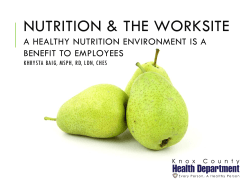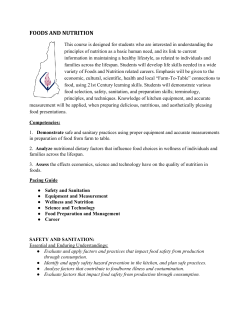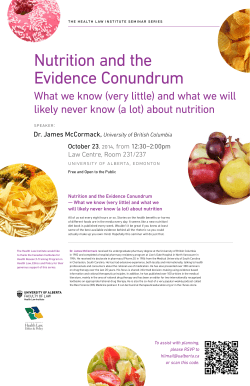
How to Build a Healthy School Environment!
1 Sunset Avenue, Hatfield, MA 01038 · 1-800-FOODPLAY · 413-247-5400 · info@foodplay.com · www.foodplay.com How to Build a Healthy School Environment! We, at FoodPlay Productions, have had the opportunity to visit thousands of schools each year bringing our live nutrition theater shows and fun-filled resources to enthusiastic audiences. We’ve learned a great deal in the process, and have seen wonderful examples of whole school communities—students, parents, teachers, food service, nurses, and administrators—working together to create a healthy school environment and an innovative and effective wellness policy. We hope this primer will be of help to you. We’ve listed 30 fun, low-budget ideas schools can use to create happy and healthy places in which to learn. It does take a healthy village to raise a healthy child, and we look forward to working with you. Thanks for your dedicated efforts! —Barbara Storper, MS, RD Think Outside the Lunchbox! FoodPlay’s Top 30 Fun Ways to Create a Healthy School Environment! 1. At the beginning of the year, create a fun way to introduce your school food service staff to students and teachers in order to give staff proud ownership of the meals they turn out and to encourage a positive relationship between all groups. Little things mean a lot—holding a special “silly hat day” or “holiday theme” in which food service staff can shine, can do a lot in creating a successful school year. 2. Take a survey or set up student groups of “Taste Testers!” to determine what students like to eat. Encourage weekly or monthly “taste tests” where students can rate different meal options or try new foods. Incorporating their favorites increases participation in breakfast and lunch programs 3. Excite teachers about nutrition and health by providing information that is of special concern to them. Keep an up-to-date bulletin board in the teachers’ room and post articles about nutrition discoveries and innovative actions other schools have tried. The more teachers find the articles relevant to their needs, the more motivated they’ll be to include them in their lesson plans. 4. Advertise menus in advance, highlighting weekly health specials. Or, create a healthy food labeling system to make it easier to recognize the best available options—perfect for a class project! 5. Try new innovative fundraising activities instead of candy sales, such as talent shows, family bingo night, auctions, tag sales, or healthy bake sales. Other options include selling class cookbooks, flowers, and calendars. 6. Provide “grab n’ go” breakfasts or a breakfast cart filled with healthy favorites such as yogurt, granola, and fresh fruit. On test days, offer special breakfasts and lunches (with financial support from the school or PTO funds!). © 2000, 2007, 2008 FoodPlay Productions, LLC. All rights reserved How to Build a Healthy School Environment, p. 1 of 4 7. Turn the cafeteria into a learning laboratory! Display posters you collect or encourage the art teacher to have students paint posters promoting healthy foods and fun physical activities that you can hang as a special “Student Art Gallery” throughout your lunchroom. 8. Celebrate diversity by serving up healthy ethnic meals from the variety of cultures represented by your student body. Put a map of the world on your cafeteria wall. Work together with social studies and language teachers to inspire students to learn where foods come from. 9. Fill vending machines with healthy foods such as water, 100% fruit and vegetable juices, low-fat milk, popcorn, pretzels, baked chips, fresh and dried fruit, yogurt, trail mix, low-fat crackers and cookies such as fig bars, gingersnaps, or graham crackers. Have students get involved. 10. Invite students, teachers, and parents to help plan the menus for school lunches, and, with community support, try to incorporate locally grown produce from nearby farms, if possible. 11. Use holidays to promote and celebrate healthy foods from different cultures. Invite parents to conduct food demonstrations with classes, sharing some family favorites. Or, invite parents to create a multi-cultural pot luck feast and talent show as a special event or fundraiser. 12. Teach students about healthy foods in the classroom before introducing them to kids in the lunchroom. Studies show that students who learn about foods in class, eat from two to nine times as many of the new healthy foods as schoolmates who do not learn about them first. 13. Encourage classes to visit the new MyPyramid website, mypyramid.gov, where students can analyze their diets, discover their nutrient needs and make healthy changes. 14. Create a fun nutrition resource cart or display filled with videos, DVDs, curricula, magazine articles, and books from which parents, teachers, and students can borrow recommended resources. 15. If there is a convenience store nearby where students buy snacks after school, have teachers incorporate a lesson to educate students about which snacks would be healthiest. Create a “Make a Snack Counter-Attack Game” where kids are asked to select the top ten healthiest snacks for less than one dollar each. Encourage them to write letters to the store managers to request that more healthy snacks are sold. 16. If possible, take a field trip to a local farm or farmers’ market to teach students where food comes from. You may even be able to offer a weekly farmers’ market at your school that teachers, kids, and parents can buy fresh produce from! 17. Start a school garden (or window sill garden!) and involve students in all aspects. Vegetables planted can then be served at mealtime. Work together with teachers to foster in class lessons about gardening and nutrition. 18. Make the teachers’ and nurse’s rooms healthy, stress-free environments—with water that is drinkable, working refrigerators, healthy snack machines, hot water machines, and space to enjoy a healthy lunch or time-out period. PTO members may be interested in setting helping create these. 19. Encourage teachers to praise students’ successes verbally or with fun rewards, such as stickers, extra recesses, walks, or parties instead of with sweets or candy. (continued) © 2000, 2007, 2008 FoodPlay Productions, LLC. All rights reserved How to Build a Healthy School Environment, p. 2 of 4 And Now, Promoting Physical Activity: 20. Enlist the help of the principal to be your school’s health leader. See if she/he will hold special lunches where kids can eat at his/her table and ask questions. Or, he/she can lead regular walks outside with classes. Or, make announcements over the loudspeaker offering inspiring healthy quotations or promoting “take-an-active-break” throughout the week. 21. Create “walking buses” or biking clubs where students can walk or bike to school together instead of taking the bus. 22. Develop interesting walking maps that classes can use to take interesting walks around the school or neighborhood while learning how to follow maps. Or create a fitness track around the school for students to use before and after school. 23. Provide students and teachers with ideas, materials, and classes to help reduce stress including yoga, meditation, tai chi, activity breaks, and reading time. 24. Invite the art teacher to lead students in mural making, where students’ favorite physical activities are painted along hallways, in stairwells, or in the gym. 25. Encourage students to meet together and come up with their own ideas for cool after-school activities. Favorites include: hip-hop or swing dancing, martial arts, juggling, yoga, or cooking. 26. Incorporate physical activity into school fundraising activities such as walk-a-thons, car washes, dance contests, or competitive sports games. 27. Encourage teachers to start class or take breaks with stretching or jumping jacks to help reduce stress and energize students. 28. Sponsor a “Health and Fitness Day”, during which students can learn about the benefits of a healthy lifestyle and have the opportunity to try new activities and healthy snacks. 29. Encourage students, teachers, and parents to participate in school-wide sports events, emphasizing the benefits of school pride, teamwork, and physical activity. 30. Last, but not least, trigger school-wide excitement and get everyone on board to create a healthy school environment by bringing innovative programs to your school. At FoodPlay Productions, we offer Emmy Award-winning nutrition education theater shows featuring amazing feats of juggling, colorful characters, music, magic, and audience participation to turn kids on to healthy habits. According to USDA, sponsored evaluations show FoodPlay’s shows dramatically improve students’ eating and exercise habits! And, FoodPlay’s research-based programs come complete with comprehensive, standards-based nutrition education materials for everyone involved—students, teachers, parents, food service, and health staff—to help schools integrate nutrition education into core curricula and keep the health messages alive all year long! For more fun ways to make nutrition come alive, visit our website: www.foodplay.com or contact us: 1-800-FOODPLAY (1-800-366-3752) © 2000, 2007, 2008 FoodPlay Productions, LLC. All rights reserved • info@foodplay.com How to Build a Healthy School Environment, p. 3 of 4 School Wellness Resource List United States Department of Agriculture www.fns.usda.gov/tn/Healthy/wellnesspolicy.html Massachusetts Public Health Association www.mphaweb.org/documents/CommunityActiontoChangeSchoolFoodPolicy.pdf New England Food and Dairy Council www.newenglanddairycouncil.org/wellness/flyers.html School Nutrition Association www.schoolwellnesspolicies.org California Project LEAN www.californiaprojectlean.org Alliance for a Healthier Generation www.healthiergeneration.org FoodPlay Productions www.foodplay.com Action for Healthy Kids • “Wellness Policy Tool” www.actionforhealthykids.org/wellnesstool/index.html • “Helping Students Make Better Food Choices in School” www.actionforhealthykids.org/pdf/Final%20Report%20-%20Color.pdf • “Resources to Improve Schools” www.actionforhealthykids.org/resources.php Center for Science in the Public Interest • “School Foods Tool Kit” www.cspinet.org/nutritionpolicy/policy_options.html#ImproveSchoolFoods • “Constructive Classroom Rewards” www.cspinet.org/nutritionpolicy/constructive_rewards.pdf © 2000, 2007, 2008 FoodPlay Productions, LLC. All rights reserved How to Build a Healthy School Environment, p. 4 of 4
© Copyright 2025





















